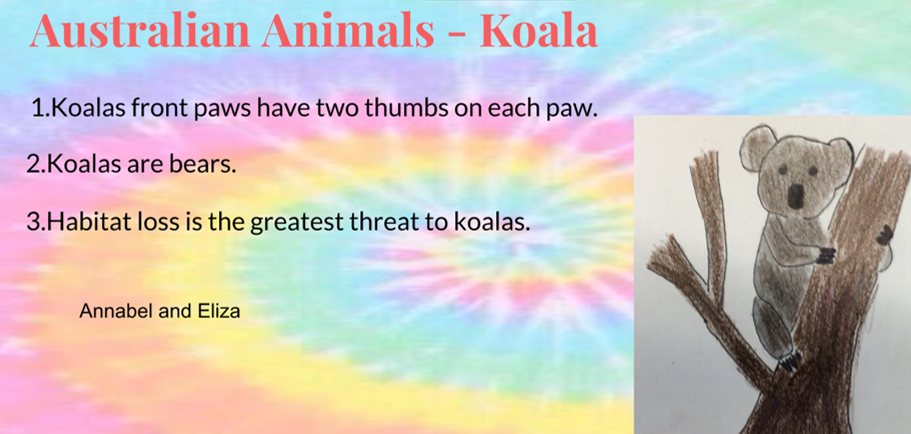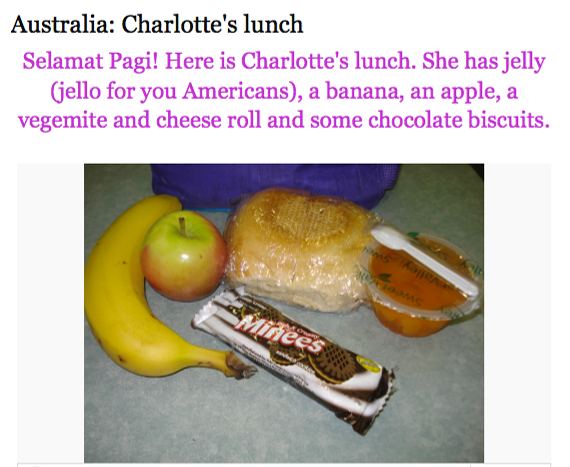One of the many advantages of having a class blog is the potential for global collaboration.
Global collaboration has always been one of my very favorite aspects of blogging with students.
There are many reasons why global collaboration is worthwhile.
- Connecting with other classes around the world is fun! I’m yet to meet a student who doesn’t enjoy getting involved in global collaboration. It just seems to spark a natural sense of curiosity and wonder, even for those who are disengaged with some aspects of traditional schooling.
- Developing global competence is a must. If we want our students to thrive in a changing labor market, live harmoniously together, and work together to solve some of our world’s big problems, they need to be comfortable with global collaboration.
- The curriculum can come alive. Many teachers worry that global collaboration is an “add-on” which they don’t have time for with a busy curriculum. To the contrary, global projects can offer an authentic and innovative way to teach and go beyond learning benchmarks.
- Global collaboration is purposeful and productive. We know our students are online. A lot. But what are they doing online? Playing games? Taking selfies? Texting? We all need downtime but perhaps we could tap into this interest in the online world and help students connect more purposefully and productively? Global collaboration could be a piece of that puzzle. This sentiment is echoed by George Couros in his post, Hope is Not a Strategy.
Maybe you like the idea of connecting with other classes, but don’t know where to start? This guide will walk you through many different entry points to global collaboration.
In this post, I’ve outlined a framework that’s weaved from my own experiences. I hope you’ll add to the guide by sharing your own ideas and experiences.
Contents
Three Stages Of Global Collaboration
Stage One: Informal Collaboration
Two classes using their own blogs
Two classes using one joint blog
Multiple classes using their own blogs
Multiple classes using one joint blog
First, you need a blog
Okay, you certainly don’t have to have a blog to get involved in global collaboration but there are advantages to having one.
A blog is an online hub. It acts as a place where classes can meet, collaborate, converse, and learn together. You can document your journey with global collaboration and also post content (text, photos, videos, songs etc.) to share with other classes.
A blog is your virtual home. You may want to make your classroom community discoverable if you’re interested in forming connections. This would be through a public blog. A public blog also offers an authentic and ongoing way to cover digital citizenship, as I have written about before. Together, your classroom community can make decisions about what will be posted including names, photos, personal information, and so on (refer to Should Your Class Or Student Blogs Be Public Or Private to dive into this topic further).
If you’re brand new to blogging, we have a guide to get you started. Check it out.
Three Stages Of Global Collaboration
There are three key stages to involving your class in global collaboration and we’ll be going through each one.
These stages don’t represent a continuum and you don’t have to progress through the first stage and then move onto the next.
The great thing about global collaboration is the flexibility.
- Sometimes you can do big things, other times small things.
- Sometimes you might be a leader, other times you might just follow along.
- Sometimes your project might be over in an hour, or a few days. Other times, your project might span for many weeks or a semester.
- Sometimes the project might involve one other class, other times it might involve a handful of classes you know, or hundreds of classes you don’t know (yet).
Stage One: Informal Collaboration
What?
The first stage of connecting with other classes is informal collaboration. This is where you dip your toes in, reach out to someone, and just try some form of connection. You don’t need to have big goals or objectives and it doesn’t have to be an ongoing thing.
Why?
Informal collaboration is simply an entry point that’s low risk and not daunting. If it doesn’t work out, it doesn’t matter. If it does work out, you never know where it could take you!
How?
Simply find someone who has a class that looks like a good match to your own class (similar age/subject, a location you’d like to connect with etc.). You might put a call out on Twitter, check out our list of class blogs which we update twice a year, or simply google for class blogs. Then it’s just a matter of asking! Leave a blog comment, send a tweet, or send an email if there is an address listed.
Then what?
Once you’ve asked someone if they want to collaborate and they say yes, decide what you want to do. Do you want to leave comments on each others’ blogs? Perhaps you could post something special for the other class to comment on (e.g. film your class singing a song or giving a tour of the school). Or you might want to do a casual Skype call. Never used Skype before? Get our PDF full of tips for running a successful Skype call.
Tips
Remember it works both ways. If you want others to comment on your blog, make sure you visit their blogs as well. And keep the conversations going by asking questions etc.
You might also find that it’s easy enough to find connections in first world/western countries — USA, Australia, UK, New Zealand etc. Once you get familiar with global collaboration, you might consider ways to connect with educators in other parts of the world. This can broaden your students’ horizons even further.
Stage Two: Join A Project
What?
The first experiences many classes have with global projects involve joining pre-organized collaborations. You don’t need to think of the project idea and find your own connections. There are agencies and groups that can do this for you.
Why?
You might not have the connections, the ideas, or the willingness/time/capacity to organize your own global project. Or, you might like to sometimes join in pre-arranged projects and sometimes set up your own collaborations or projects.
Examples
Below is a list of projects that classes can join from anywhere in the world. This list is far from exhaustive. There are so many wonderful projects out there that are free and open to anyone. We invite you to add your own suggestions in a comment.
1) Student Blogging Challenge
The Student Blogging Challenge runs twice yearly starting in March and October. It is made up of a series of 10 weekly tasks all designed to improve blogging and commenting skills while connecting students with a global audience and being supported by a team of blogging mentors.
The Challenge is open to both class blogs and to individual student bloggers from all over the world and of all ages. Participants can complete as many of the tasks as they like and in any order.

2) 100 Word Challenge
![]() This is a popular project run by retired English head teacher, Julia Skinner. Each week a prompt is published and students are invited to respond in under 100 words.
This is a popular project run by retired English head teacher, Julia Skinner. Each week a prompt is published and students are invited to respond in under 100 words.
Julia can also help connect your class with a hub where three classes from around the world band together to support each other with comments. Additionally, Julia has a team of volunteers who comment on students’ work each week.
Find out more about how this project works in our interview with Julia Skinner.
3) International Dot Day
 Every year, millions of students and educators connect on or around September 15th to celebrate creativity, courage, and collaboration.
Every year, millions of students and educators connect on or around September 15th to celebrate creativity, courage, and collaboration.
Participating in International Dot Day is simple. You sign up on the website, read The Dot book to your class, and express yourself in any way that’s in line with themes from the book. Then finally, you’re invited to connect with other classes around the world and the Dot Day organizers can help you do this.
Find out more about participating in International Dot Day in our 2017 post.
4) Skype in the Classroom
Skype in the Classroom is an online community that enables teachers to bring the world into their classroom via Skype.
- Go on virtual field trips
- Play Mystery Skype
- Meet with guest speakers
- Participate in a global collaboration project
- Take part in a Skype lesson
Teachers can sign up for Skype in the Classroom on the Microsoft Educator website.
Find out more about Skype in the Classroom in our interview with Skype Master Teacher, Julie Hembree.
5) ePals
 This is a website that helps connect K-12 classrooms around the world.
This is a website that helps connect K-12 classrooms around the world.
Teachers can search for learning partners based on country, age group, language, subject etc.
ePals allows you to set up pen pal exchanges. This is where students can communicate privately with other students. These are teacher moderated.
You can also join in global projects (called ‘experiences’). There is a range of projects available targeted at different age groups and subject areas.
6) The Global Read Aloud
The Global Read Aloud was created by Pernille Ripp in 2010 and is now very popular. It is a yearly event that spans six weeks starting each October.
Participants sign up to read the same book aloud to their students and then use any form of technology (Skype, blogs, Edmodo etc.) to connect throughout the six weeks.
This quote from Pernille explains The Global Read Aloud concept,
Global collaboration is necessary to show students that they are part of something bigger than them. That the world needs to be protected and that we need to care for all people. You can show them pictures of kids in other countries but why not have them speak to each other? Then the caring can begin.
Stage Three: Start A Project
Hopefully, as you build up your professional learning network, you might start meeting some educators that you work well with. This could be through your informal connections or structured projects. These educators might prove to be a good match in terms of reliability, student goals, age of students, standards etc.
When this happens, a natural next step can be to start your own project.
Starting your own project can be very beneficial because you can customize the learning experience to meet your students’ precise needs and interests. You can also extend and build on connections over time.
I’m going to show you some examples of projects that I’ve devised over the years with different teachers.
These global blogging projects took four different formats:
- Two classes using their own blogs
- Two classes using one joint blog
- Multiple classes using their own blogs
- Multiple classes using one joint blog
1) Two Classes Using Their Own Blogs
This is a fairly easy entry point to setting up your own global project and there are many ways you can go about it.
Short Project Example: Two Truths And One Lie
Some projects might just span a few days like Two Truths and One Lie. This was a project I worked on with grade 3/4 students and Linda Yollis‘ third grade class at the end of 2017.
Each class worked together on a collaborative Google Slide presentation. The students worked with a partner to come up with one slide. The slide had two facts and one “lie” about their country’s animals, landmarks, culture, or any other area they were interested in. The slideshows were published on the class blogs and the other class was invited to guess the lies in comments after doing their own research.
You can read more about the Two Truths And One Lie project here. This would be easy to adapt to older year levels as well.
A similar short term project that you might be interested in reading about is The Monster Project.
Longer Project Example: The Flat Stanley Project
Some projects might go on for multiple weeks. One example that my grade two students enjoyed was The Flat Stanley project.
This was a collaboration with Open The Door To B4 in New Zealand. We both read Flat Stanley then sent our own paper Stanleys in the mail along with a journal for a NZ student to fill in about Stanley’s adventure overseas. There was great joy when the journals were returned home and a few Skype calls complemented the project.
The Flat Stanley project has been popular for many years and there is a website where you can find out more information about how to run your own version or find classes to connect with.
2) Two Classes Using One Joint Blog
One of my earliest blogging collaborations was with Linda Yollis and her third grade students. We met via a simple exchange of comments. We then started regularly commenting on each other’s blogs and sometimes posted a special post just for the other class (e.g. a traditional song).
From there we decided to set up a joint blog which we called Collaboration Corner. (You can check out the blog here, although note that it hasn’t been maintained in many years so some embeds aren’t working as they should).
The first project we worked on was a simple one — The Lunchbox Project. Each day a different student would take a photo of their lunch and create an audio recording about it. The other class could ask questions and conversations evolved.
Following that, the students voted on a new project which was to do with the school environment.
There’s a lot of scope for working collaboratively on a joint blog no matter what age or subject you teach. This could be in addition to a class blog or instead of a class blog.
3) Multiple Classes Using Their Own Blog
Once you start getting to know other teachers, you might find you have a number of strong connections from different locations. Why not bring them together to create a bigger project?
QuadBlogging
You could start with something like QuadBlogging. This is a concept that UK educator David Mitchell came up with.
The format is simple. Four blogging classes come together and learn about one another one week at a time. Each week, a different blog in the quad is the focus and the other three classes take the time to visit and comment on their blog.
Here is a video our class made with their blogging buddies about QuadBlogging many years ago.
I tried out QuadBlogging when the concept was in its infancy. David Mitchell has since built more of a framework around it and can help you find your own quad. Check out quadblogging.net.
The Tale Trail
 Another example I worked on with multiple classes using their own blogs was called The Tale Trail. Six classes around the world collaboratively wrote a story together. Each class would have three days to come up with their portion of the story before passing it on to the next class to continue.
Another example I worked on with multiple classes using their own blogs was called The Tale Trail. Six classes around the world collaboratively wrote a story together. Each class would have three days to come up with their portion of the story before passing it on to the next class to continue.
Again, there is a lot of scope to broaden this sort of project!
You can read more about The Tale Trail on Shawn Avery’s class blog. Shawn instigated this project.
4) Multiple Classes Using One Joint Blog
If you really want to step up your global collaborations, you might like to look into having multiple classes working on one joint blog.
This certainly requires a little more organization and it can be helpful to have one teacher take on more of a leadership role to set up the blog, distribute tasks, come up with schedules, and keep the momentum going.
Outcome: Fun And Learning
Sometimes these sorts of projects might just be for the sake of learning more about the world, building communication skills, and authentically teaching the curriculum.
A few examples I’ve been involved in setting up include:
- Our World, Our Stories: Over a 7 week period, 6 classes worldwide collaborated on a joint blog sharing their stories. Each week a different class was the lead class. They published a post about the weekly topic — games, food, traditional songs/stories etc. The other classes read the posts, possibly published their own posts, and left blog comments.
- Our World, Our Numbers: Over a 12 week period, 7 classes worldwide collaborated on a joint blog sharing their mathematical lives. A different class led a mathematical topic every week or so (currency, seasons, time zones, population data etc.). The lead class would publish posts and reply to comments. The other classes read the posts, possibly published their own posts, and left blog comments.
Outcome: Fun, Learning, And Taking Action
Sometimes your outcomes might go beyond simply learning and collaborating. There might be a greater purpose. Students can come together to take action and either raise awareness about a cause or improve conditions for others in some way. Perhaps they can use their privilege and voice to contribute to a better world.
An example of this sort of project was The Ugandan Global Project.
Like Our World, Our Stories and Our World, Our Numbers, there was a collaborative blog where students from four continents shared and learned through weekly topics. One of the participants was a Ugandan school and the culminating event was a fundraiser to help purchase a playground and dining hall for this underprivileged community.
The outcomes of this project exceeded all expectations. Not only was there a lot of fun and learning, but $20,000 was raised for the Ugandan School. There were after effects too when members of a US community heard about the project and decided to travel to Uganda to volunteer.
While these wouldn’t be the sorts of projects you’d do all the time, it can be worth thinking about how you could take a collaboration one step further to make a difference in the world.
5 Tips For Success
There are no hard and fast rules about global collaboration and there are sure to be some benefits however you approach it, however, here are a few tips from my own experiences that might help.
1) Start Small
Think quality over quantity. You don’t have to be involved in every project going around and you don’t have to connect with too many different classes.
Once you find one or two classes that you have a solid connection with, there’s no reason why you can’t try a few different projects with the same class. There are many benefits to extending and deepening your collaboration.
2) Project Management
When working on your own projects or collaborations with other classes, you need to consider how you’ll tackle project management. I’ve always been a big fan of having shared Google Sheets and Google Docs to lay out all the ideas and timetables.
A little bit of behind the scenes organization can really pay off.
Communication is crucial so keep in regular contact with the other teachers you’re working with, whether that be through email, Skype, Twitter … or a tool that suits you.
3) Involve Students
It’s easy for global projects to become teacher managed but it’s obviously a good idea to involve students in all aspects of the project.
As students get older, they can be more involved in the behind the scenes planning too. Whatever the age of the student, there should be some element of ‘voice and choice’. This can be as simple as students electing what topics they’d like to explore, what questions they’d like to ask, how they’d like to present their work etc.
4) Involve The Community
Global collaboration might be a novel concept in your school community. Share the excitement and learning by inviting others to get involved.
This might be through things like:
- Asking your principal and parents if they want to come and watch a Skype session.
- Inviting the local community to take part in a fundraiser.
- Asking other classes in your team or school to take part alongside you (maybe your partner class also has other classes at their school they could invite to even up the numbers).
5) Celebrate And Reflect
A culminating event can be a satisfying way for students to showcase and celebrate their learning at the end of a project.
For simple one-off connections, you might write a blog post. Or for bigger projects, this might look like a movie, fundraising event, song, Skype party, digital story, community event, or art display.
Be sure to discuss with your students what worked and what ideas they have for next time. Think of ways you can build on the project or connection. A thorough debrief and reflection can lead to even more powerful outcomes in the future!
Conclusion
It can certainly seem a little daunting to get started with global collaboration in the beginning but there’s a strong chance that once you dip your toes in and see what your students get out of it, you’ll be hooked!
Please leave a comment and share any of your own experiences with global collaboration. If you’re aware of any other good projects or entry points that we haven’t mentioned, be sure to let us know!











Hi Kathleen,
Thanks so much for your post! As someone who is interested in learning more about global collaboration in the classroom, I really appreciate the thorough breakdown that you provide. Since this post is from a few years back, have you had any recent experiences (especially during covid) that have changed any of your tips? Maybe some advancements in technology that might alter how you would go about a global collaborative classroom?
Hi Kathryn so glad to hear you enjoyed the post! While it was written a few years ago, the content is still very relevant today. You might also be interested in anther article by Kathleen that goes in-depth into teaching online during the covid crises: https://www.theedublogger.com/teaching-online-school-closures/
Thanks for this article. By the way, would it be okay if I start blogging with a free account and decide later on hosting the blog? Will the transition be easy enough to migrate from a freeaccount to a paid one? Hope you could shed light on the query. Thank you.
Hi Kateryna,
You can definitely start with a free blog and then upgrade to pro if you decide to. Transitioning is straightforward. It’s basically a matter of pressing a button. All your work and settings will remain. If you need any help with this in the future, feel free to email us.
You might also be interested in our Teacher Challenge series which walks you through setting up a blog.
Good luck!
I really enjoyed your article. I am a librarian who works with instructors in an university setting. An instructor had asked me about setting up a website for two classes from different schools to work together. What is the advantage of a blog over a website or wiki? I have had problems in the past with people leaving obscene comments on a blog.
Hi Jean,
So glad to hear you enjoyed the article.
A blog is typically a website that’s just updated more regularly with new posts. A traditional website is more of a static space. So if you’re looking for a site where classes will offer updates about projects or class work etc, a blog would make sense.
You could perhaps use a wiki, however, wikis may be more about cataloging information and building a resource or encyclopedia of sorts, rather than sharing or discussing etc. A wiki doesn’t come to mind as a natural platform for a collaborative project, however, I’m sure it can be done. You can also add a wiki to your blog as is explained here https://help.edublogs.org/wiki-plugin/
In regards to commenting, you can turn comments off in your blog settings. https://help.edublogs.org/enable-and-disable-comments-on-future-posts-and-pages/ You can set up comment moderation.
Hope that helps, however, if you need more assistance with helping your instructor setting up a site for their collaboration, feel free to email us.
Good luck!
Wow…way to light a fire under me, Kathleen!
I’m a teacher-librarian from Grand Forks, BC Canada, and I’m grateful for your many inspiring ideas on how to bring the world into our learning commons. I’m already planning for the fall, and I can see now how concepts of global citizenship, alternative forms of text and fresh opportunities to read and write could be worked into my vision.
I especially love the notion that we can join a project already built, as opposed to starting from the ground up, and I can see the 100 Word Challenge as a great way to introduce blogs to my students. I also love your idea for the Lunchbox Exchange. What a cool way to connect kids: A love for food is pretty much universal, after all!
Finally, I hope this isn’t too far off base, but have you ever seen any global blogging projects done that involve crafts? I have a particularly crafty Grade 4 cohort coming up, and something along these lines would be a great way to get them reading and writing more.
Thanks again,
Melissa
Thank you for your enthusiastic comment, Melissa! Your vision sounds fantastic. I just love the idea of integrating craft into a global project. I can’t think of a project where this is done off the top of my head but maybe you could start something? If you could find another class that was interested, you could even create tutorials for each other or something like that.
Do let me know if you start something. I’d love to check it out!
Kathleen
o i really enjoy reading your work that you post